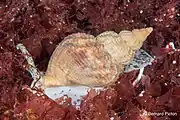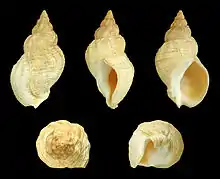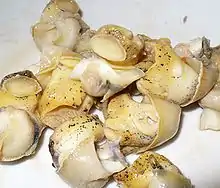| Buccinum undatum Temporal range: 28.5Mya – present | |
|---|---|
 | |
| A live individual of Buccinum undatum being held up above the substrate | |
| Scientific classification | |
| Domain: | Eukaryota |
| Kingdom: | Animalia |
| Phylum: | Mollusca |
| Class: | Gastropoda |
| Subclass: | Caenogastropoda |
| Order: | Neogastropoda |
| Family: | Tudiclidae |
| Genus: | Buccinum |
| Species: | B. undatum |
| Binomial name | |
| Buccinum undatum | |
| Synonyms | |
| |
Buccinum undatum, the common whelk or the waved buccinum, is a large, edible marine gastropod in the family Buccinidae, the "true whelks".[1]
Distribution
This species is a familiar part of the marine fauna of the Northern Atlantic and is found on the shores of the United Kingdom, Ireland, France, Norway, Iceland, various other northwest European countries, some Arctic islands, and North America as far south as New Jersey. They prefer colder temperatures, and cannot survive at temperatures above 29 °C.[2]
Habitat
This species is mainly found on soft bottoms in the sublittoral zone, and occasionally on the littoral fringe, where it is sometimes found alive at low tide. It does not adapt well to life in the intertidal zone, due to its intolerance for low salinities. If exposed to air, it may crawl from its shell, risking desiccation.[2]
 Buccinum undatum off Oanes, Norway
Buccinum undatum off Oanes, Norway Buccinum undatum from Krakvika, Skjerstad Fjord, Norway
Buccinum undatum from Krakvika, Skjerstad Fjord, Norway- Buccinum undatum in the Netherlands, with visible hydroids (Hydractinia echinata) growing on its shell
- Buccinum undatum looking for a partner and mating
Shell


This species' solid, ovate-conical, ventricose shell is very pale, white, yellowish or reddish. In life, the shell is covered in a bright, yellowish-brown periostracum. The spire contains seven or eight whorls. These are convex and crossed by oblique folds, thick and waved. The shell surface has a sculpture of vertical, wavy folds (hence the name undatum, which means wavy). The wavy folds are crossed by numerous incised, very prominent spiral lines, some of which are paired. The white and very large aperture of the shell is broadly oval and tapers to a deeply notched siphonal canal. The outer lip is arched.
The maximum height of the shell is 10 cm and the maximum width is 6 cm. The animal emits a thin and copious slime.[3]
This species is very variable in size, and also in its form, which is more or less inflated. In many cases the oblique folds are not apparent, and sometimes the transverse striae have wholly disappeared. The epidermis is of a deep brown. It varies also in its coloring, which in some specimens is of a bright yellow or violet, surrounded with one or several reddish bands.[4]
Trophic connections
This species of whelk feeds on live bivalves, and are, in turn, preyed upon by several fish (cod, dogfish, etc.) and crustaceans.[2] They may benefit from seastar feeding, by eating the extracted bivalve remains abandoned by the seastar.[5]
Parasites
Larval stages of Stephanostomum baccatum were found in the digestive gland of B. undatum.[6]
As a food item

Buccinum undatum is eaten widely, sometimes referred to by its French name bulot. A strong fishery exists on many shores around the world. They are trapped in pots using dogfish and brown crab as bait.[7] It can be confused with Neptunea antiqua (red whelk), which is poisonous to humans.[8]
Ecology and population decline
Disappearing or diminishing populations of whelks have been observed since the early 1970s, especially in the North Sea and the Wadden Sea. Additionally, vast beds of empty shells have been discovered where no living whelks are present. Imposex, the occurrence of male gonads on female whelks, has been detected since the early 1990s, and is thought to be a product of the shipping industry.[2] Specifically, TBT has been shown to reduce viability of whelk populations.[9] Common whelk egg cases can be found washed up on the intertidal zone of beaches, and are colloquially known as sea wash balls.
References
- ↑ Fraussen, K.; Gofas, S. (2014). Buccinum undatum Linnaeus, 1758. Accessed through: World Register of Marine Species at http://www.marinespecies.org/aphia.php?p=taxdetails&id=138878 on 2015-02-18
- 1 2 3 4 Ten Hallers-Tjabbes, C.C., Everaarts, J.M., Mensink, B.P., & Boon, J.P. (1996) The Decline of the North Sea Whelk (Buccinum undatum L.) between 1970 and 1990: A Natural or Human-induced Event? 17:1-3. pp. 333-43. Marine Ecology.
- ↑ G.W. Tryon, Systematic Conchology vol. I, Philadelphia, 1882
- ↑ Kiener (1840). General species and iconography of recent shells: comprising the Massena Museum, the collection of Lamarck, the collection of the Museum of Natural History, and the recent discoveries of travellers; Boston: W.D. Ticknor,1837
- ↑ Himmelman, J.H. and Hamel, J.-R. (1993) Diet, behaviour and reproduction of the whelk Buccinum undatum in the northern Gulf of St. Lawrence, eastern Canada. 116:3. pp. 423-430. Marine Biology.
- ↑ Sommerville C. (1978). "The histopathology of Stephanochasmus baccatus Nicoll, 1907 in the digestive gland of Buccinum undatum (L.)". Journal of Fish Diseases 1(3): 219-232. doi:10.1111/j.1365-2761.1978.tb00024.x.
- ↑ Fahy, E. (2001). Conflict between two inshore fisheries: for whelk (Buccinum undatum) and brown crab (Cancer pagurus), in the southwest Irish Sea. 465: 73-83. Hydrobiologia.
- ↑ Anthoni, U.; Bohlin, L:; Larsen, C.; Nielsen, P.; Nielsen, N.H.; and Christophersen, C. (1989). The toxin tetramine from the "edible" whelk Neptunea antiqua. Toxicon 27: 717-723.
- ↑ Mensink, B.P., Everaarts, J.M., Kralt, H., ten Hallers-Tjabbes, C.C., & Boon, J.P. (1996) Tributyltin exposure in early life stages induces the development of male sexual characteristics in the common whelk, Buccinum undatum. 42: 1-4. pp. 151-154. Marine Environmental Research.
External links
- MarLIN: The Marine Life Information Network for Britain & Ireland
- R. Tucker Abbott & Percy A. Morris, 1995, Shells of the Atlantic and Gulf coasts and the West Indies, Houghton Mifflin, Boston
- ARKive
